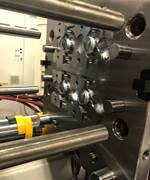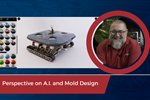 Just as shops can start with AI to achieve quick wins, build momentum and scale solutions, AI was used to generate this illustration to fill in for a missing image. Source | Stock, Copilot
Just as shops can start with AI to achieve quick wins, build momentum and scale solutions, AI was used to generate this illustration to fill in for a missing image. Source | Stock, CopilotAs a technology professional in the manufacturing industry, I see immense potential for Machine Learning (ML), Generative artificial intelligence (AI), specifically Large Language Models (LLMs) like GPT, to disrupt and transform the engineering-to-order (ETO) moldmaking sector.
In an industry focused on customization and meeting specific customer needs, using AI does more than just make things a bit more efficient; it can seriously change the way we do things. It helps cut down on manual tasks and speeds up delivery, all while making everything more accurate.
What sets today’s AI apart is its ability to operate within your current systems and processes, often without the need for costly infrastructure upgrades. With models like GPT and other LLMs, businesses can unlock insights and efficiencies from existing data, whether structured or unstructured, live or historical.
Shops can even include external data sources along with internal data as a possibility within secured environments, such as monitoring commodity prices on the market to support supply chain forecasting, planning or vendor analysis. This makes AI adoption more practical than ever, even for organizations without extensive IT resources.
AI is no longer a distant concept or a tool limited to tech giants. It’s here, and it’s reshaping industries by automating routine tasks, improving decision-making and enhancing customer experiences. The challenge isn’t whether AI can be useful — it’s figuring out how to integrate it in ways that make sense for your business.
AI implementation doesn’t need to start with sweeping changes or significant investments. Instead, experimentation in small, targeted areas can yield quick wins, build internal momentum and provide a foundation for scaling AI across the organization.
Here are four areas you can experiment with and support:
1. Identify Repetitive or Time-Consuming Processes
Start by looking for processes in your organization that are repetitive, time-consuming or error-prone.
Examples could include design standardization to organize, categorize and optimize CAD files for mold bases, ejector systems or cooling layouts. Automate the generation of design based on historical project data or customer specifications.
2. Start With Off-the-Shelf Tools
You don’t need to build complex AI systems from scratch to begin experimentation. These tools often offer no-code or low-code solutions, enabling nontechnical users to experiment without significant reliance on IT or deep technical expertise.
Depending on your defined use case, you have pretrained models like Amazon Rekognition. This tool can analyze photos of molded parts to identify surface irregularities, structural defects or deviations from design specifications. Text analysis with Amazon Comprehend can help extract critical details for tasks like RFQ, design documents or customer communications.
These natural language processing models can reduce manual data entry and ensure accuracy in error-prone tasks. These tools provide low-risk entry points for your AI adoption, and when you partner with a hyperscaler like AWS or someone else, you can leverage their platform for low-risk reward and adoption.
3. Expect To Fail But Don’t Give Up
Successful businesses embrace experimentation, viewing pilot projects as opportunities to learn and refine rather than expecting instant success. AI adoption requires room for trial and error, with setbacks reframed as valuable feedback.
To effectively conduct trial and error with AI adoption in a small or medium-sized business, start by defining clear objectives. For example, you might aim to reduce manual processing time by 20% or improve customer response accuracy to 95%. Next, conduct a small-scale pilot project with a specific team or process to help manage risks.
Use simple feedback forms to document measurable successes (such as quicker invoice processing) and challenges (for example, incorrect data entries), along with notes on potential causes and observations. Organize all feedback in a shared tool like Google Sheets or Excel, categorizing issues such as technical difficulties or process misalignments, and create summary reports with key findings and action plans.
To track improvements, use visual tools such as simple graphs to demonstrate progress, like a 10% decrease in errors or a 15% increase in task efficiency. Build a culture of learning by discussing outcomes in team meetings, celebrating progress and involving staff in refining and scaling successful practices.
It’s important to prioritize iteration over perfection and to celebrate insights just as much as outcomes. Once successful use cases are identified, document the results, standardize best practices and share stories to encourage broader adoption.
For example, you can use ChatGPT to streamline CAD design by generating ideas for optimal parting line placement, draft angles or gating systems based on specific mold requirements. By inputting design constraints or material specifications into ChatGPT, you can receive tailored suggestions for improving cooling channels or reducing the risk of warping.
Track the results by noting the time saved in ideation and design revisions. Document areas where ChatGPT’s suggestions improved efficiency or required manual adjustments. Other use cases for mold builders include optimizing material selection, troubleshooting manufacturing defects, estimating costs for molds and production, providing maintenance tips to extend tool life, creating detailed work instructions for shopfloor operations and streamlining administrative tasks such as scheduling, documentation and reporting.
4. Focus Your Efforts
Choose a specific pilot project that either explores a particular process in depth or examines the connections across multiple stages of a workflow. A deep-dive approach analyzes one area in detail to uncover opportunities for improvement, whereas a cross-functional approach assesses how different stages interact to identify gaps and inefficiencies. This process helps refine organizational design, which structures roles, workflows and systems to enhance coordination and align resources with strategic goals.
Keep the project’s scope manageable so it can be implemented and evaluated within a few weeks or months, avoiding lengthy timelines. Typically, low-risk pilot projects that are suitable for introducing AI focus on internal organizational tools. Examples include knowledge-based systems that summarize and extract information from training manuals for engineers and ones that provide buyers with insights into internal procurement purchasing trends using ERP data. In contrast, use cases that involve customer or public data typically require strict governance and well-defined parameters.
The path to AI adoption doesn’t have to be overwhelming. Focus on small, measurable experiments, leverage off-the-shelf tools and make mistakes.
AI Is No Longer the Future — It’s the Present
The path to AI adoption doesn’t have to be overwhelming. Focus on small, measurable experiments, leverage off-the-shelf tools and make mistakes. Position your shop for success in an AI-driven world or, in fact, any technology disruptor that occurs. Take the first step, look for a process or problem where AI can make an immediate impact. Start small, measure your results and use those insights to build a foundation for broader transformation.
The key is to begin — because your decisions today will shape your company’s success in the future. By adopting an incremental approach and experimenting in targeted areas, you can begin to realize the benefits of AI without the perceived investment.
Related Content
Simplifying Cooling Design With Advanced Automation
CAD/CAM software with automated mold design features streamlines waterline, baffle and conformal cooling design, making it easier to act on insights from flow analysis.
Read MoreEnhancing Global Manufacturing Visibility: How Digital Moulds Solved SKF's Data Accessibility Challenges
SKF improved global manufacturing visibility and data accessibility through Digital Moulds' cloud-based monitoring system, enhancing real-time machine status tracking.
Read MoreMMT Chats: The Rise of Tooling Digitalization
MoldMaking Technology Editorial Director Christina Fuges chats with Bob Vancoillie with the Consumer Division of Johnson & Johnson about OEM corporate initiatives for digitizing tooling.
Read MoreMMT Chats: Helping Small Manufacturers Embrace AI
IT Expert Mina Girges shares simple ways to implement AI by starting small, fostering innovation, integrating securely and scaling strategically to enhance efficiency.
Read MoreRead Next
Using AI to Transform Part and Mold Manufacturing
A Michigan startup is leveraging AI-designed molds in a bid to “commoditize” tool building and optimize parts in the process.
Read MoreTooling 4.0: Connecting Industry 4.0 Technology to Your Molds and Molding Process
A packaging supplier applies Industry 4.0 technology to its injection molds so that components talk to each another to understand the dynamics of what is happening inside the mold.
Read MoreVIDEO: Perspective on AI and Mold Design
Bill Genc of TopSolid shares his perspective on the benefits of and barriers to using artificial intelligence in mold design.
Read More






















